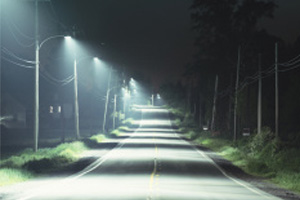You have no items in your shopping basket.
The Advantages of LED Street Lighting

There are many reasons why LED technology should be a consideration in street and area lighting. LED lights are environmentally friendly because they consume so little energy. They are free from hazardous chemicals such as mercury and lead which release toxins. They are not made with arc tubes like traditional HID but instead use diodes. Diodes help boost the resistance of the lamp giving them a higher rate of durability compared with other lamp technology, which ultimately provides a significantly longer lifespan.
LED is becoming more common in street lighting applications because it projects the lumen output of the LED more efficiently, which allows for wider coverage of a consistent light pattern. Uniformity is one of the benefits of a well-designed solid state lighting product. Improved uniformity means fewer hot spots (and subsequent pools of darkness) versus traditional light sources, thus, improving visual acuity and safety. Lighting specifiers often had to over-compensate with an abundance of initial lumens to account for lumen depreciation over the life of the light source. Dark pools just continue to get darker as lamp lumens depreciate over their rated life. LEDs depreciate more slowly than many traditional light sources such as metal halide or induction technologies. In technologies with less light deprecation over time, fewer initial lumens can be designed into the application. All of these factors, including higher light uniformity, improved colour rendering and high color temperature, allowing for wider coverage, can reduce the wattage of fixtures required in many outdoor applications. This significantly reduces the cost of energy, and allows for lower cost of ownership over the life of the system.
But Not Always Apples-to-Apples
However, the largest mistake being made is considering LED technology versus traditional light sources as an apples-to-apples comparison. Purchasers or specifiers of LED products, including those for street lighting, want manufacturers to decipher semiconductor lingo andLED street light make comparisons to existing lighting technologies and competing LED luminaires. This is difficult as there is nothing traditional about solid state lighting because data is reported differently for LEDs. As lighting is re-invented through technology, the industry should also re-evaluate lighting needs by application. The lumen and footcandle requirements of the past were largely created due to the characteristics of traditional lighting technologies. Colour rendering, correlated color temperature, uniformity, and lumen depreciation differ across technologies, affecting the visual acuity of the illuminated task. The current new metrics designed for comparisons are largely just another failed attempt to deal with this revolution in the lighting industry.
What Should Engineers Consider When Specifying LED in Street Lighting?
So, how can one best evaluate optical design and performance when considering LED for street lighting? Lumens (light) on task and directionality of light are not new concepts, but they are now more important than ever for road lighting and similar applications. Understanding where the lumens are directed out of the luminaire is essential when comparing products for all the important reasons: property appearance (day and night), safety, and quality. The new IES BUG rating system (TM-15-07) can provide some level of comparison. Lumens per watt, as a sole metric, can result in poor selection of an outdoor luminaire. The light distribution pattern, uniformity, and optical efficiencies are valuable comparisons that can be made across competing products. Focusing on illuminance levels on task and optical distribution, versus a lumens per fixture and lumens per watt number is the best way to evaluate.
In addition, LED street lights are very directional since they produce evenly distributed light patterns. In comparison, traditional High Pressure Sodium street lamps often require higher output to achieve the same results of LED in the same application. HPS requires a greater input to achieve the desired output of light, typically demanding measurably more energy.
In most cases today, LED lamps have a higher cost per unit than its HPS brethren. However, the increasing demand and evolving LED technologies are driving costs down. Though even at today’s cost, the long term economies can far outweigh the initial investment. Depending on the application, the wider distribution coverage of LED luminaires can reduce the amount of wattage needed and longer life can reduce replacement and maintenance costs.
Article written by Eye Lighting International
